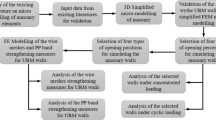Abstract
A series of analytical studies were conducted to investigate the behaviour of masonry walls supporting a reinforced concrete slab under a number of fire scenarios. The main purpose is to use various types of sub-assembly in predicting the structural behaviour in fire. The analysis of sub-frames rather than complete structures is attractive since they have the potential to reduce computation time dramatically, which could be of significance if large numbers of results need to be generated for design documents. The analyses are all performed using a finite element program, called MasSET (Masonry Subject to Elevated Temperatures), whose most recent development has been the capability to take into account the interface element between the masonry wall and the slab. Separation, sliding, and opening and closing of initial gaps at the interface between the masonry wall and the reinforced concrete slab are accounted for by adjusting the properties of interface elements.
Similar content being viewed by others
References
CP 121, Code of Practice for Walling, Pt 1: Brick and Block Masonry, British Standards Institution, London, 1973.
EUROCODE No. 6. Design of masonry structures. Pt 10: Structural fire design, Commission of European Communities, 1990.
G.M.E. Cooke, “Thermal bowing and how it affects the design of fire separating constructions,” Interflam 88, Fourth Int. Fire Conf. 22–24, March, Church College Cambridge, 1988, pp. 230–236.
S.J. Lawerence and N. Gnankrishnan, “ The fire resistance of masonry walls ”, Fire National Structural Engineering Conference, Melbourne, 1987, pp. 431–437.
A. Nadjai, M.E. O'Gara, and F. Ali, “Finite element modelling of compartment masonry walls in fire,” International Journal of Computer and Structures, vol. 81, 2003, pp. 1923–1930.
A. Nadjai, M.E. O'Gara, F. Ali, and D. Laverty, “A numerical model for the behaviour of masonry under elevated temperatures,” International journal of Fire and Materials, vol. 27, 2003, pp. 1–20.
D.J. O'Connor and B.W. Scotney, “Determination of equivalent thermal response parameters for evaluating the structural response of beams subjected to transient thermal environments,” International Journal of Mathematics, Education, Science and Technology, vol. 26, 1995, pp. 111–130.
EUROCODE No. 4. Design of composite steel and concrete structures. Pt 1.2: Structural fire design (second draft). Commission of the European Communities, 1992.
G.A. Khoury, B.N. Gringer, and P.J.E. Sullivan, “Transient thermal strain of concrete: Literature review, conditions within specimen and behaviour of individual constituents,” Magazine of Concrete Research, vol. 37, 1985, pp. 131–144.
Y. Anderberg and S. Thelanderson, “Stress deformation characteristics of concrete at high temperatures,” Division of Structural Mechanics and Concrete Construction, Lund Institute of Technology, No. 15, 1976.
S. Thelanderson, “Effect of high temperature on tensile strength of concrete,” Division of Structural Mechanics and Concrete Construction, Institute of Technology, Neostyled, No. 27, 1971.
R.E. Goodman, R.L.Taylor, and T. L. Brekke, “A model for the mechanics of jointed rock,” Soil Mechanics and Foundations Division, ASCE, vol. 94, 1968, pp. 637–659.
A. Nadjai,“The behaviour of steel frames with semi-rigid joints containing unreinforced infill panels,“ PhD thesis, The University of Sheffield, 1993.
I.M. May and J.H. Naji, “Nonlinear analysis of infilled frames under monotonic and cyclic loading,” International Journal of Computer & Structures, vol. 38, 1991, pp. 149–160.
G.J.W. King and P.C., Pandey, “The analysis of infilled frames using finite elements,” The Proceeding of the Institution of Civil. Engineers, vol. 65, 1978, pp. 749–760.
N. Gnanakrishnan, The Effect of end Restraint on the Stability of Masonry Walls Exposed to Fire, National Building Technology Centre, Technical Records No. 531.
D. Laverty, A. Nadjai, and D.J. O'Connor, “Modelling of thermo-strutural response of concrete masonry walls subjected to fire,” Journal of Applied Science, vol. 10, 2001, pp. 3–19.
Author information
Authors and Affiliations
Corresponding author
Rights and permissions
About this article
Cite this article
Nadjai, A., O'Gara, M., Ali, F. et al. Compartment Masonry Walls in Fire Situations. Fire Technol 42, 211–231 (2006). https://doi.org/10.1007/s10694-006-7509-6
Published:
Issue Date:
DOI: https://doi.org/10.1007/s10694-006-7509-6




